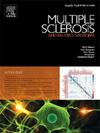Does cognitive performance explain the gap between physiological and perceived fall-risk in people with multiple sclerosis?
IF 2.9
3区 医学
Q2 CLINICAL NEUROLOGY
引用次数: 0
Abstract
Background
Cognitive impairment is linked with increased risk of falls in people with multiple sclerosis (pwMS), but it is not clear whether cognitive performance may help to account for the discordance between fall-risk due to actual physiological functioning and the individual's perception of their fall-risk. This study examined the relationship between cognitive performance and the concordance/discordance of physiological and perceived fall-risk in pwMS.
Methods
: In this single-center cross-sectional analysis of 201 pwMS, proxies for physiological (gait speed) and perceived (Modified Falls Efficacy Scale) fall-risk were collected. Participants were categorized into 4 groups using established cut-off values: high physiological – high perceived (Hphy-Hper), high physiological – low perceived (Hphy-Lper), low physiological – low perceived (Lphy-Lper), and low physiological – high perceived (Lphy-Hper) fall-risk. Cognitive performance was evaluated using the NeuroTrax computerized cognitive battery, which generates a global cognitive score (GCS) as well as scores for individual cognitive domains.
Results
Overall, 27.4 % of participants exhibited a discordance between physiological and perceived fall-risk. Individuals with discordant fall-risk did not have worse cognitive scores than individuals with concordant fall-risk, whether GCS or individual cognitive domains. However, among concordant groups, participants in the Hphy-Hper group had worse cognitive scores (GCS) as well as information processing, attention, motor skills, executive function and visual spatial domain scores than participants in the Lphy-Lper group.
Conclusion
In this study, one in 4 pwMS had a discordance between their physiological and perceived fall-risk. This discordance was not explained by cognitive performance.
求助全文
约1分钟内获得全文
求助全文
来源期刊

Multiple sclerosis and related disorders
CLINICAL NEUROLOGY-
CiteScore
5.80
自引率
20.00%
发文量
814
审稿时长
66 days
期刊介绍:
Multiple Sclerosis is an area of ever expanding research and escalating publications. Multiple Sclerosis and Related Disorders is a wide ranging international journal supported by key researchers from all neuroscience domains that focus on MS and associated disease of the central nervous system. The primary aim of this new journal is the rapid publication of high quality original research in the field. Important secondary aims will be timely updates and editorials on important scientific and clinical care advances, controversies in the field, and invited opinion articles from current thought leaders on topical issues. One section of the journal will focus on teaching, written to enhance the practice of community and academic neurologists involved in the care of MS patients. Summaries of key articles written for a lay audience will be provided as an on-line resource.
A team of four chief editors is supported by leading section editors who will commission and appraise original and review articles concerning: clinical neurology, neuroimaging, neuropathology, neuroepidemiology, therapeutics, genetics / transcriptomics, experimental models, neuroimmunology, biomarkers, neuropsychology, neurorehabilitation, measurement scales, teaching, neuroethics and lay communication.
 求助内容:
求助内容: 应助结果提醒方式:
应助结果提醒方式:


